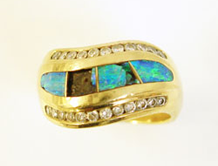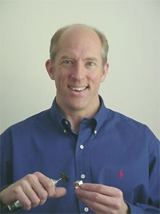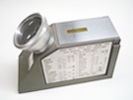Chalcedony rough material
Chalcedony is a form of Quartz.
What is Crystal Quartz? The best way to describe Quartz and Chalcedony and how they are similar and yet different from each other is as follows. Imagine Lego blocks. Each individual Lego block is one tiny Quartz molecule of Silicon diOxide ( 1 part Silicon and 2 parts of Oxygen ). When you snap together Lego blocks into the form of a cube, that cube is like the structure of a Quartz crystal. It has a nice orderly and symmetrical structure. A Quartz crystal has a hexagonal structure rather than a cube, but you get the idea.
What is Cryptocrystaline Quartz (Chalcedony)? Instead of snapping the Lego blocks together, if you dumped them all into a box in a jumbled manner, it is still Quartz pieces but they are not crystalized. That is what cryptocrystaline Quartz is like. It is just as hard (hardness of 7) as crystalized Quartz and it is still Silicon diOxide, but it is not crystalized. That form of disorder is also known as 'amorphous'. Glass is also amorphous.
Types of Chalcedony: There are numerous varieties of Chalcedony. They are mostly differentiated based on their different colors and different color patterns. Below is a list of some of the main forms of Chalcedony and a link to one of our pages describing each one. If we do not yet have a page for one of them, please check back as we are continually adding new pages.
Sardonyx: Is normally the name given to dark brown colored Chalcedony.
Carnelian: Is the name given to Chalcedony which is reddish brown or orangy red in color. The colors can vary between reddish and orangy and all are considered to be Carnelian.
Chrysoprase: Is a bright green form of Chalcedony. This can range from a very light green to a dark green. The best Chrysoprase is a bright green. If you see dark green Chrysoprase, you need to ask if it is dyed as much of the dark green material is dyed.
Black Onyx: Refers to Black Chalcedony. Almost all black Onyx is dyed. It is one of the gems which is considered acceptable to be dyed. If dyed Onyx was not used, there would be almost no Onyx in the market because even colored black Chalcedony is so uncommon in nature. I have more information about this on our Black Onyx page.
Another use of the term Onyx is the term Mexican Onyx. Mexican Onyx is NOT Chalcedony. It is banded Calcite.
Layered Onyx: The term Onyx is also used sometimes to refer to a form of Chalcedony in which the coloring occurs in flat layers in which the layers alternate between white and black and sometimes brown colors. This form of Onyx with the flat layers is what is used by carvers to make Cameos.
Agate: Agate refers to forms of Chalcedony which have color pattterns which are banded or maybe have patters in them resembling moss or other similar characteristics.
Jasper: Jasper is multi-colored Chalcedony. There are dozens of different names for the different forms of Jasper. Some are unique due to their color patters, which may be found in only one place in the world.
Picture Jasper: Is a type of Jasper in which the coloring formed in patterns which resemble hills or other landscape scenes. Some have even had blue areas which resemble lakes, if one uses just a bit of imaginagion.
Blue Chalcedony: Is a form of Chalcedony which is colored in a nice light or dark blue color. This has been popular in recent years. It sometimes occurs with druzy crystal or botryoidal surfaces on one side.
Lavendar Chalcedony: Come in purplish, pinkish or lavendar shades of color.



